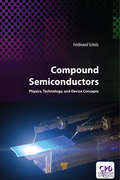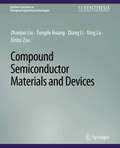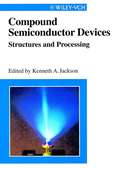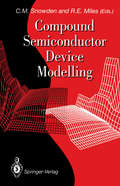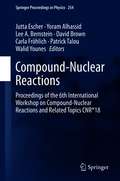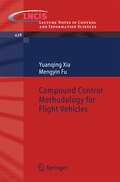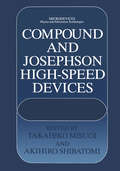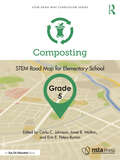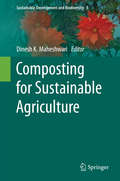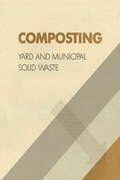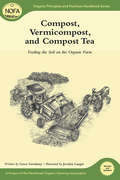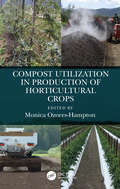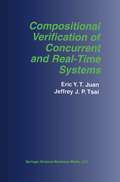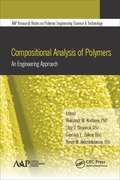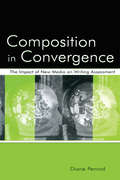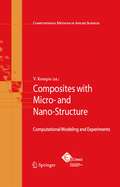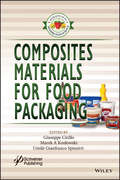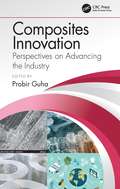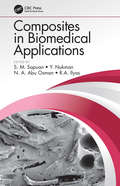- Table View
- List View
Compound Semiconductors: Physics, Technology, and Device Concepts
by Ferdinand ScholzThis book provides an overview of compound semiconductor materials and their technology. After presenting a theoretical background, it describes the relevant material preparation technologies for bulk and thin-layer epitaxial growth. It then briefly discusses the electrical, optical, and structural properties of semiconductors, complemented by a description of the most popular characterization tools, before more complex hetero- and low-dimensional structures are discussed. A special chapter is devoted to GaN and related materials, owing to their huge importance in modern optoelectronic and electronic devices, on the one hand, and their particular properties compared to other compound semiconductors, on the other. In the last part of the book, the physics and functionality of optoelectronic and electronic device structures (LEDs, laser diodes, solar cells, field-effect and heterojunction bipolar transistors) are discussed on the basis of the specific properties of compound semiconductors presented in the preceding chapters of the book. Compound semiconductors form the back-bone of all opto-electronic and electronic devices besides the classical Si electronics. Currently the most important field is solid state lighting with highly efficient LEDs emitting visible light. Also laser diodes of all wavelength ranges between mid-infrared and near ultraviolet have been the enabler for a huge number of unprecedented applications like CDs and DVDs for entertainment and data storage, not to speak about the internet, which would be impossible without optical data communications with infrared laser diodes as key elements. This book provides a concise overview over this class of materials, including the most important technological aspects for their fabrication and characterisation, also covering the most relevant devices based on compound semiconductors. It presents therefore an excellent introduction into this subject not only for students, but also for engineers and scientist who intend to put their focus on this field of science.
Compound Semiconductor Materials and Devices (Synthesis Lectures on Emerging Engineering Technologies)
by Zhaojun Liu Tongde Huang Qiang Li Xing Lu Xinbo ZouEver since its invention in the 1980s, the compound semiconductor heterojunction-based high electron mobility transistor (HEMT) has been widely used in radio frequency (RF) applications. This book provides readers with broad coverage on techniques and new trends of HEMT, employing leading compound semiconductors, III-N and III-V materials. The content includes an overview of GaN HEMT device-scaling technologies and experimental research breakthroughs in fabricating various GaN MOSHEMT transistors. Readers are offered an inspiring example of monolithic integration of HEMT with LEDs, too. The authors compile the most relevant aspects of III-V HEMT, including the current status of state-of-art HEMTs, their possibility of replacing the Si CMOS transistor channel, and growth opportunities of III-V materials on an Si substrate. With detailed exploration and explanations, the book is a helpful source suitable for anyone learning about and working on compound semiconductor devices.
Compound Semiconductor Devices: Structures and Processing
by Kenneth A. JacksonCompound Semiconductor Devices provides a comprehensive insight into today's standard technologies, covering the vast range of semiconductor products and their possible applications. The materials covered runs from the basics of conventional semiconductor technology through standard,power and opto semiconductors, to highly complex memories and microcontrollers and the special devices and modules for smartcards, automotive electronics, consumer electronics and telecommunications. Some chapters are devoted to the production of semiconductor components and their use in electronic systems as well as to quality management. The book offers students and users a unique overview of technology, architecture and areas of application of semiconductor products.
Compound Semiconductor Device Modelling
by Christopher M. Snowden Robert E. MilesCompound semiconductor devices form the foundation of solid-state microwave and optoelectronic technologies used in many modern communication systems. In common with their low frequency counterparts, these devices are often represented using equivalent circuit models, but it is often necessary to resort to physical models in order to gain insight into the detailed operation of compound semiconductor devices. Many of the earliest physical models were indeed developed to understand the 'unusual' phenomena which occur at high frequencies. Such was the case with the Gunn and IMPATI diodes, which led to an increased interest in using numerical simulation methods. Contemporary devices often have feature sizes so small that they no longer operate within the familiar traditional framework, and hot electron or even quantum mechanical models are required. The need for accurate and efficient models suitable for computer aided design has increased with the demand for a wider range of integrated devices for operation at microwave, millimetre and optical frequencies. The apparent complexity of equivalent circuit and physics-based models distinguishes high frequency devices from their low frequency counterparts . . Over the past twenty years a wide range of modelling techniques have emerged suitable for describing the operation of compound semiconductor devices. This book brings together for the first time the most popular techniques in everyday use by engineers and scientists. The book specifically addresses the requirements and techniques suitable for modelling GaAs, InP. ternary and quaternary semiconductor devices found in modern technology.
Compound-Nuclear Reactions: Proceedings of the 6th International Workshop on Compound-Nuclear Reactions and Related Topics CNR*18 (Springer Proceedings in Physics #254)
by Jutta Escher Yoram Alhassid Lee A. Bernstein David Brown Carla Fröhlich Patrick Talou Walid YounesThe Compound-Nuclear Reaction and Related Topics (CNR*) international workshop series was initiated in 2007 with a meeting near Yosemite National Park. It has since been held in Bordeaux (2009), Prague (2011), Sao Paulo (2013), Tokyo (2015), and Berkeley, California (2018). The workshop series brings together experts in nuclear theory, experiment, data evaluations, and applications, and fosters interactions among these groups. Topics of interest include: nuclear reaction mechanisms, optical model, direct reactions and the compound nucleus, pre-equilibrium reactions, fusion and fission, cross section measurements (direct and indirect methods), Hauser-Feshbach theory (limits and extensions), compound-nuclear decays, particle and gamma emission, level densities, strength functions, nuclear structure for compound-nuclear reactions, nuclear energy, nuclear astrophysics, and other topics. This peer-reviewed proceedings volume presents papers and poster summaries from the 6th International Workshop on Compound-Nuclear Reactions and Related Topics CNR*18, held on September 24-28, 2018, at Lawrence Berkeley National Lab, Berkeley, CA.
Compound Control Methodology for Flight Vehicles (Lecture Notes in Control and Information Sciences #438)
by Yuanqing Xia Mengyin Fu“Compound Control Methodology for Flight Vehicles” focuses on new control methods for flight vehicles. In this monograph, the concept of compound control is introduced. It is demonstrated that both Sliding Mode Control (SMC) and Active Disturbance Rejection Control (ADRC) have their own advantages and limitations, i.e., chattering of SMC and the observability of extended state observer (ESO), respectively. It is shown that compound control combines their advantages and improves the performance of the closed-loop systems. The book is self-contained, providing sufficient mathematical foundations for understanding the contents of each chapter. It will be of significant interest to scientists and engineers engaged in the field of flight vehicle control.
Compound and Josephson High-Speed Devices (Microdevices)
by Takahiko Misugi Akihiro ShibatomiIn recent years, III-V devices, integrated circuits, and superconducting integrated circuits have emerged as leading contenders for high-frequency and ultrahigh speed applications. GaAs MESFETs have been applied in microwave systems as low-noise and high-power amplifiers since the early 1970s, replacing silicon devices. The heterojunction high-electron-mobility transistor (HEMT), invented in 1980, has become a key component for satellite broadcasting receiver systems, serving as the ultra-low-noise device at 12 GHz. Furthermore, the heterojunction bipolar transistor (HBT) has been considered as having the highest switching speed and cutoff frequency in the semiconductor device field. Initially most of these devices were used for analog high-frequency applications, but there is also a strong need to develop high-speed III-V digital devices for computer, telecom munication, and instrumentation systems, to replace silicon high-speed devices, because of the switching-speed and power-dissipation limitations of silicon. The potential high speed and low power dissipation of digital integrated circuits using GaAs MESFET, HEMT, HBT, and superconducting Josephson junction devices has evoked tremendous competition in the race to develop such technology. A technology review shows that Japanese research institutes and companies have taken the lead in the development of these devices, and some integrated circuits have already been applied to supercomputers in Japan. The activities of Japanese research institutes and companies in the III-V and superconducting device fields have been superior for three reasons. First, bulk crystal growth, epitaxial growth, process, and design technology were developed at the same time.
Composting, Grade 5: STEM Road Map for Elementary School (STEM Road Map Curriculum Series)
by Carla C. Johnson Janet B. Walton Erin E. Peters-BurtonWhat if you could challenge your fifth-grade students to investigate the role of composting in solid waste management? With this volume in the STEM Road Map Curriculum Series, you can! Composting outlines a journey that will steer your students toward authentic problem solving while grounding them in integrated STEM disciplines. Like the other volumes in the series, this book is designed to meet the growing need to infuse real-world learning into K–12 classrooms.This interdisciplinary, four-lesson module uses project- and problem-based learning to help students use the engineering design process (EDP) to design and create prototypes of compost systems and build a full-scale composting system for school use. Students will synthesize their learning about biotic and abiotic factors, decomposition, and engineering design as they learn about various types of compost systems, create their own portable compost bins, and create materials for a composting publicity campaign at their school.To support this goal, students will do the following: Identify and explain interdependent relationships in ecosystems Compare and contrast several ecosystems Describe how compost systems are designed and constructed and apply this understanding to creating prototypes of various compost systems Understand the concept of scale and apply this understanding to create scaled models of compost systems Apply their understanding of composting, compost systems, and the EDP to create a full-scale compost system for the school Measure various characteristics of compost The STEM Road Map Curriculum Series is anchored in the Next Generation Science Standards, the Common Core State Standards, and the Framework for 21st Century Learning. In-depth and flexible, Composting can be used as a whole unit or in part to meet the needs of districts, schools, and teachers who are charting a course toward an integrated STEM approach.
Composting, Grade 5: STEM Road Map for Elementary School (STEM Road Map Curriculum Series)
by Carla C. Johnson Janet B. Walton Erin E. Peters-BurtonWhat if you could challenge your fifth-grade students to investigate the role of composting in solid waste management? With this volume in the STEM Road Map Curriculum Series, you can! Composting outlines a journey that will steer your students toward authentic problem solving while grounding them in integrated STEM disciplines. Like the other volumes in the series, this book is designed to meet the growing need to infuse real-world learning into K–12 classrooms.This interdisciplinary, four-lesson module uses project- and problem-based learning to help students use the engineering design process (EDP) to design and create prototypes of compost systems and build a full-scale composting system for school use. Students will synthesize their learning about biotic and abiotic factors, decomposition, and engineering design as they learn about various types of compost systems, create their own portable compost bins, and create materials for a composting publicity campaign at their school.To support this goal, students will do the following: Identify and explain interdependent relationships in ecosystems Compare and contrast several ecosystems Describe how compost systems are designed and constructed and apply this understanding to creating prototypes of various compost systems Understand the concept of scale and apply this understanding to create scaled models of compost systems Apply their understanding of composting, compost systems, and the EDP to create a full-scale compost system for the school Measure various characteristics of compost The STEM Road Map Curriculum Series is anchored in the Next Generation Science Standards, the Common Core State Standards, and the Framework for 21st Century Learning. In-depth and flexible, Composting can be used as a whole unit or in part to meet the needs of districts, schools, and teachers who are charting a course toward an integrated STEM approach.
Composting for Sustainable Agriculture (Sustainable Development and Biodiversity #3)
by Dinesh K. MaheshwariThe dramatic worldwide increase in agricultural and industrial productivity has created severe environmental problems. Soil and groundwater reservoirs have been polluted with pesticides, xenobiotics and agro-chemicals. The global consensus to reduce inputs of chemical pesticides and agrochemical fertilizers, which are perceived at being hazardous by some consumers, has provided opportunities for the development of novel, benign sustainable crop management strategies.The future of agricultural depends upon our ability to enhance the productivity without damage to their long-term production potential. One of the strategies is the application of effective microbial products beneficial for both farmers and ecosystems. This kind of approach can ensure both ecological and economic sustainability. Soil microbial populations are immersed in framework of interactions, which are known to affect plant fitness and soil quality.For betterment of life of human being, improved quality and variety of products are formed due to versatile action of different group of microorganisms, Microbes are able to degrade solid waste material into compost which is a mixture of decayed organic matter, manure etc. Incomplete microbial degradation of organic waste where the microbial process varies aerobic to anaerobic form is stated as compost, if added to soil improves plant growth and development. The biological activities and microbial metabolism in the soil contribute to alter its mixture and fertility. Incorporation of organic remain in the form of compost is known to influence favourably the physio-chemical and biological properties of soil. The beneficial activities bestowed upon plants by compost utilization are multifaceted, hence most promising alternatives for achieving sustainable agricultural production.An increased awareness on compost has led to their use in agricultural concern. Contents in the present book will comprised various chapters on the role of beneficial bacteria in the composting process. The application is depicted to achieve the attainable productivity besides, in disease management and suppressiveness of organisms of phytopathogenic in nature. Significance of the compost elicits certain responses e.g. soil reclamation, soil fertility, soil health and disease management exhibit due to quality compost amendment in soil. It serves as low cost prospective option for sustainable crop production and protection.
Composting: Yard and Municipal Solid Waste
by United States Environmental Protection AgencyThis book aims to aid decision-makers in planning, siting, designing, and operating composting facilities. It is also useful to citizens, regulators, consultants, and vendors interested in the composting of yard trimmings and municipal solid waste.
Composting: Yard and Municipal Solid Waste
by United States Environmental Protection AgencyThis book aims to aid decision-makers in planning, siting, designing, and operating composting facilities. It is also useful to citizens, regulators, consultants, and vendors interested in the composting of yard trimmings and municipal solid waste.
Compost, Vermicompost and Compost Tea: Feeding the Soil on the Organic Farm (Organic Principles and Practices Handbook Series)
by Grace Gershuny Jocelyn LangerPart of the NOFA Guides series. Information on composting techniques, including: Principles and biology of composting Temperature, aeration and moisture control Composting methods Materials (additives and inoculants, biodynamic preparations) About costs (site preparation, equipment, labor and time) What do you do with it? Compost tea and other brewed microbial cultures Compost and the law With extended appendices including a recipe calculator, potting mix recipes, and a sample compost production budget sheet.
Compost Utilization in Production of Horticultural Crops
by Dr Monica Ozores-HamptonCompost Utilization in Production of Horticultural Crops provides information for the compost industry to develop horticulture production efforts and techniques. This highly practical book contains information applicable to current production issues facing the fruit and nuts, vegetable, and ornamentals and turfgrass industry. Written by scientific experts, chapters evaluate the uses of compost for greater crop yields and decreased plant disease and pesticide application, irrigation water and fertilizer demand. Considering compost use increases carbon sequestration, the book provides guidelines on converting safe waste materials into composted soil amendments while minimizing negative impacts on the environment. Chapters cover the diversity and variability on compost uses of available feedstocks; composting methods, application rates, methods and timing; and considers the benefits of application alone or combined with other organic or inorganic nutrient sources. Practical reference for regular use by professionals in compost and horticulture industries. Presents information for both agricultural and waste management. Addresses the effects of compost on soil health and food safety. Discusses compost quality and compost as a supplement in soil fertility programs. Features information on compost nematodes management, compost teas effect on foliar diseases, and the economic impact of compost on crop production. This book is essentail reading for fruit and nuts, vegetable, ornamental, landscape and turfgrass producers; waste and compost industry representatives, consultants and regulators; and academic plant and soil science researchers.
Compost Utilization in Production of Horticultural Crops
by Monica Ozores-HamptonCompost Utilization in Production of Horticultural Crops provides information for the compost industry to develop horticulture production efforts and techniques. This highly practical book contains information applicable to current production issues facing the fruit and nuts, vegetable, and ornamentals and turfgrass industry. Written by scientific experts, chapters evaluate the uses of compost for greater crop yields and decreased plant disease and pesticide application, irrigation water and fertilizer demand. Considering compost use increases carbon sequestration, the book provides guidelines on converting safe waste materials into composted soil amendments while minimizing negative impacts on the environment. Chapters cover the diversity and variability on compost uses of available feedstocks; composting methods, application rates, methods and timing; and considers the benefits of application alone or combined with other organic or inorganic nutrient sources. Practical reference for regular use by professionals in compost and horticulture industries. Presents information for both agricultural and waste management. Addresses the effects of compost on soil health and food safety. Discusses compost quality and compost as a supplement in soil fertility programs. Features information on compost nematodes management, compost teas effect on foliar diseases, and the economic impact of compost on crop production. This book is essentail reading for fruit and nuts, vegetable, ornamental, landscape and turfgrass producers; waste and compost industry representatives, consultants and regulators; and academic plant and soil science researchers.
Compositional Verification of Concurrent and Real-Time Systems (The Springer International Series in Engineering and Computer Science #676)
by Eric Y.T. Juan Jeffrey J.P. TsaiWith the rapid growth of networking and high-computing power, the demand for large-scale and complex software systems has increased dramatically. Many of the software systems support or supplant human control of safety-critical systems such as flight control systems, space shuttle control systems, aircraft avionics control systems, robotics, patient monitoring systems, nuclear power plant control systems, and so on. Failure of safety-critical systems could result in great disasters and loss of human life. Therefore, software used for safety critical systems should preserve high assurance properties. In order to comply with high assurance properties, a safety-critical system often shares resources between multiple concurrently active computing agents and must meet rigid real-time constraints. However, concurrency and timing constraints make the development of a safety-critical system much more error prone and arduous. The correctness of software systems nowadays depends mainly on the work of testing and debugging. Testing and debugging involve the process of de tecting, locating, analyzing, isolating, and correcting suspected faults using the runtime information of a system. However, testing and debugging are not sufficient to prove the correctness of a safety-critical system. In contrast, static analysis is supported by formalisms to specify the system precisely. Formal verification methods are then applied to prove the logical correctness of the system with respect to the specification. Formal verifica tion gives us greater confidence that safety-critical systems meet the desired assurance properties in order to avoid disastrous consequences.
Compositional Analysis of Polymers: An Engineering Approach
by Aleksandr M. Kochnev Oleg V. Stoyanov Gennady E. Zaikov Renat M. AkhmetkhanovTechnical and technological development demands the creation of new materials that are stronger, more reliable, and more durable-materials with new properties. This new book covers a broad range of polymeric materials and technology and provides researchers in polymer science and technology with new research on the functional materials production c
Composition in Convergence: The Impact of New Media on Writing Assessment
by Diane PenrodComposition in Convergence: The Impact of New Media on Writing Assessment considers how technological forms--such as computers and online courses--transform the assessment of writing, in addition to text classroom activity. Much has been written on how technology has affected writing, but assessment has had little attention. In this book, author Diane Penrod examines how, on the one hand, computer technology and interactive material create a disruption of conventional literacy practices (reading, writing, interpreting, and critique), while, on the other hand, the influence of computers allows teachers to propose and develop new models for thinking and writing to engage students in real-world settings.This text is intended for scholars and educators in writing and composition, educational assessment, writing and technology, computers and composition, and electronic literacy. In addition, it is appropriate for graduate students planning to teach and assess electronic writing or teach in online environments.
Composition in Convergence: The Impact of New Media on Writing Assessment
by Diane PenrodComposition in Convergence: The Impact of New Media on Writing Assessment considers how technological forms--such as computers and online courses--transform the assessment of writing, in addition to text classroom activity. Much has been written on how technology has affected writing, but assessment has had little attention. In this book, author Diane Penrod examines how, on the one hand, computer technology and interactive material create a disruption of conventional literacy practices (reading, writing, interpreting, and critique), while, on the other hand, the influence of computers allows teachers to propose and develop new models for thinking and writing to engage students in real-world settings.This text is intended for scholars and educators in writing and composition, educational assessment, writing and technology, computers and composition, and electronic literacy. In addition, it is appropriate for graduate students planning to teach and assess electronic writing or teach in online environments.
Composites with Micro- and Nano-Structure: Computational Modeling and Experiments (Computational Methods in Applied Sciences #9)
by Vladimír KompišThis book presents new results in the knowledge and simulations for composite nano-materials. It includes selected, extended papers presented in the thematic ECCOMAS conference on Composites with Micro- and Nano-Structure (CMNS) – Computational Modelling and Experiments. It contains atomistic and continuum numerical methods and experimental validation for composite materials reinforced with particles or fibres, porous materials, homogenization and other important topics.
Composites Materials for Food Packaging: Innovative And Environmentally Sound Strategies (Insight to Modern Food Science)
by Giuseppe Cirillo Marek A. Kozlowski Umile Gianfranco SpizzirriThe book is intended as an overview on the recent and more relevant developments in the application of composite materials for food packaging applications, emphasizing the scientific outcome arising from the physico-chemical properties of such engineered materials with the needs of food quality and safety. Consumers are increasingly conscious of the strong relationship between food quality and health, and thus the request of packaging materials allowing the quality and safety of foods to be highly preserved. As a result, scientists from both academia and industry work to increase the quality of the food storage, with this book meant as a link between scientific and industrial research, showing how the development in composite materials can impact the field. In the book, the inorganic materials employed for the preparation of composite material is extensively analyzed in terms of physico-chemical properties, environmental and reusability concerns, as well as food interaction features, highlighting the importance and the potential limitations of each approach.
Composites Materials for Food Packaging: Innovative And Environmentally Sound Strategies (Insight to Modern Food Science)
by Marek Kozlowski Giuseppe Cirillo Umile Gianfranco SpizzirriThe book is intended as an overview on the recent and more relevant developments in the application of composite materials for food packaging applications, emphasizing the scientific outcome arising from the physico-chemical properties of such engineered materials with the needs of food quality and safety. Consumers are increasingly conscious of the strong relationship between food quality and health, and thus the request of packaging materials allowing the quality and safety of foods to be highly preserved. As a result, scientists from both academia and industry work to increase the quality of the food storage, with this book meant as a link between scientific and industrial research, showing how the development in composite materials can impact the field. In the book, the inorganic materials employed for the preparation of composite material is extensively analyzed in terms of physico-chemical properties, environmental and reusability concerns, as well as food interaction features, highlighting the importance and the potential limitations of each approach.
Composites Innovation: Perspectives on Advancing the Industry
by Probir GuhaComposites Innovation: Perspectives on Advancing the Industry provides a panoramic view of innovations in the composites industry, including discussions from business leaders and the university research community on advanced applications in North America, advances in recycling of composites, the use of artificial intelligence, nanocomposites, and emerging smart composites technology. The book is arranged in five key segments including: how composites fit into our world; the basics of the technology; customer insights; pushing the boundaries with concepts from outside the world of composites and emerging composites technologies; and paths forward to find competitive and effective solutions in a timely manner. Key Features Considers sustainability and innovation as driving forces for the growth of composites Explores materials and process development, including chopped and continuous fiber systems Provides a landscape of the status of intellectual property and patents Discusses use of artificial intelligence to improve business systems with case studies and a new disciplined approach to ideation and innovation Features chapters by an accomplished group of global business and technology leaders With contributing authors spanning 15 time zones to pioneer new solutions with composite materials, this book provides an excellent resource for composites business leaders, researchers and educators, and industry professionals, as well as new entrants to this vibrant community.
Composites Innovation: Perspectives on Advancing the Industry
by Probir GuhaComposites Innovation: Perspectives on Advancing the Industry provides a panoramic view of innovations in the composites industry, including discussions from business leaders and the university research community on advanced applications in North America, advances in recycling of composites, the use of artificial intelligence, nanocomposites, and emerging smart composites technology. The book is arranged in five key segments including: how composites fit into our world; the basics of the technology; customer insights; pushing the boundaries with concepts from outside the world of composites and emerging composites technologies; and paths forward to find competitive and effective solutions in a timely manner. Key Features Considers sustainability and innovation as driving forces for the growth of composites Explores materials and process development, including chopped and continuous fiber systems Provides a landscape of the status of intellectual property and patents Discusses use of artificial intelligence to improve business systems with case studies and a new disciplined approach to ideation and innovation Features chapters by an accomplished group of global business and technology leaders With contributing authors spanning 15 time zones to pioneer new solutions with composite materials, this book provides an excellent resource for composites business leaders, researchers and educators, and industry professionals, as well as new entrants to this vibrant community.
Composites in Biomedical Applications
by S. M. Sapuan Y. Nukman R. A. IlyasComposites in Biomedical Applications presents a comprehensive overview on recent developments in composites and their use in biomedical applications. It features cutting-edge developments to encourage further advances in the field of composite research. Highlights a completely new research theme in polymer-based composite materials Outlines a broad range of different research fields, including polymer and natural fiber reinforcement used in the development of composites for biomedical applications Discusses advanced techniques for the development of composites and biopolymer-based composites Covers fatigue behavior, conceptual design in ergonomics design application, tissue regeneration or replacement, and skeletal bone repair of polymer composites Details the latest developments in synthesis, preparation, characterization, material evaluation, and future challenges of composite applications in the biomedical field This book is a comprehensive resource for advanced students and scientists pursuing research in the broad fields of composite materials, polymers, organic or inorganic hybrid materials, and nano-assembly.
